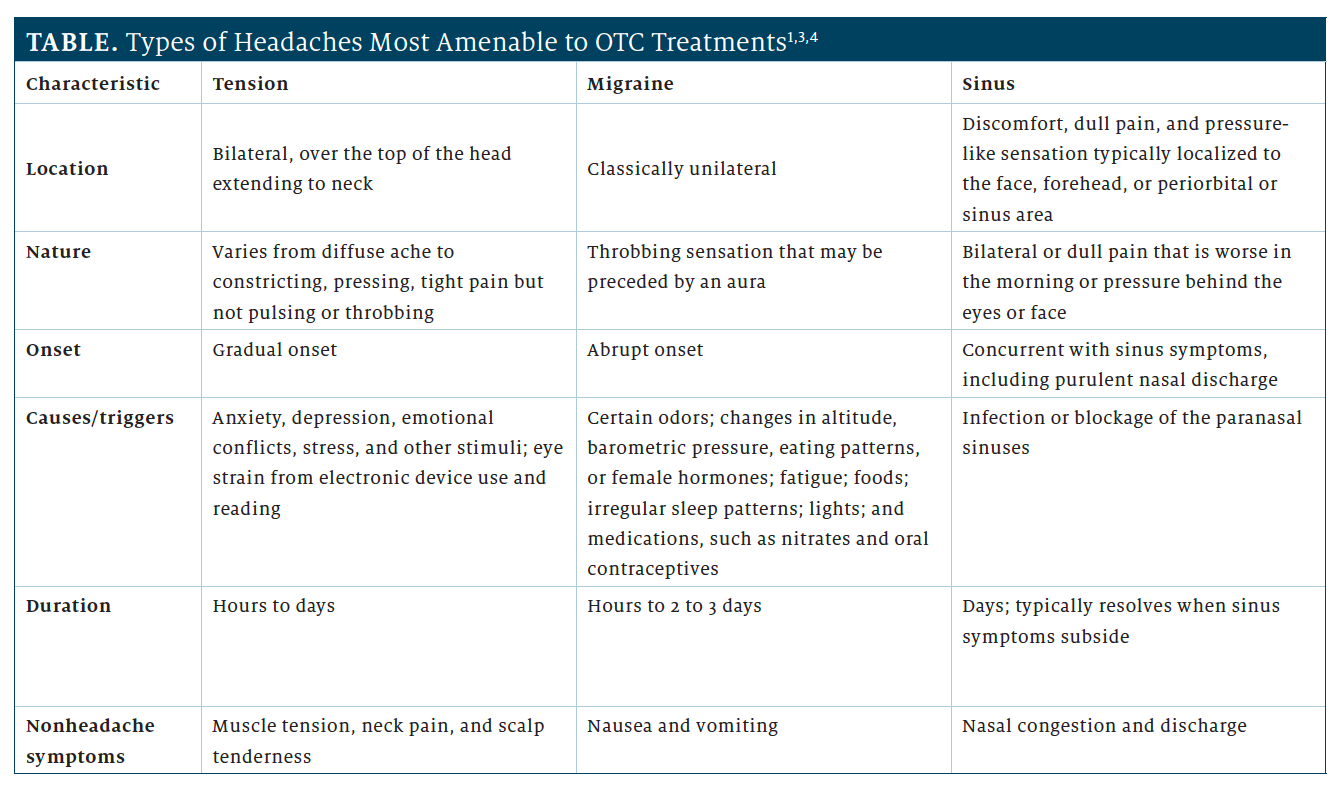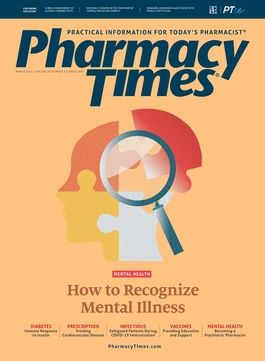Publication
Article
Pharmacy Times
Help Patients Treat Headaches Safely
Author(s):
Prior to making any recommendations, always screen for possible contraindications, drug interactions, and therapeutic duplications.
Most individuals experience a headache from time to time, but for some it is routine, which can affect overall quality of life.
Many patients elect to use OTC analgesics for the self-treatment and management of headaches, but selecting products may be overwhelming, especially for individuals with other comorbidities and/or those taking other medications. An estimated two-thirds of OTC analgesics are used for headaches.1,2
The types of headaches most frequently amenable to self-treatment with OTC analgesics include diagnosed migraines, medication-overuse headaches, sinus headaches, and tension-type headaches, also known as stress headaches (see TABLE),1,3,4 according to the Handbook of Nonprescription Drugs.

The results of a survey showed that 24% of patients chronically overused OTC analgesics and that just 14.5% were ever advised by a health care professional to limit use of these agents for acute headaches.1,2 As frontline health care providers, pharmacists are positioned to guide patients in the proper use of these nonprescription analgesics and can encourage them to seek further medical evaluations when warranted if self-treatment is not appropriate, especially for those with recurring or severe headaches or undiagnosed migraines.
COUNSELING POINTS
Prior to making any recommendations, pharmacists should always screen for possible contraindications, drug interactions, and therapeutic duplications. Pharmacists can also identify those pharmacological agents that may cause or exacerbate headaches, make clinical recommendations accordingly and encourage patients to discuss concerns with their primary care providers.
Patients who do not find relief with the use of OTC analgesics should always be referred for further medical evaluation because effective prescription therapies are available that may be beneficial. When counseling patients about the use of OTC analgesics, pharmacists can relay the following information to them1:
- Consult the primary care provider prior to using any of these products if breastfeeding or pregnant or if an individual has a preexisting medical condition or takes other medications.
- If appropriate, patients with diagnosed migraines who can predict the onset may benefit from taking an analgesic before the event known to trigger a migraine.
- Individuals with a history of hepatic disease should avoid the use of acetaminophen.
- Limit dosage of acetaminophen to no more than 4 grams per day to avoid potential liver damage.
- Take nonsteroidal anti-inflammatory drugs (NSAIDS) and salicylates with food or milk to avoid gastrointestinal (GI) upset.
In addition, caution patients not to do the following:1
- administer aspirin or other salicylates to children younger than 15 years who are recovering from chicken pox or have influenza symptoms;
- exceed recommended dosages; however, patients should discuss any concerns with a primary care provider;
- take aspirin if taking medications for arthritis, diabetes, or gout, unless directed by a primary care provider;
- take aspirin or NSAIDS if allergic to aspirin or have asthma or nasal polyps; take acetaminophen if appropriate instead;
- take aspirin or NSAIDS if there is a history of GI disorders, heart failure, kidney or liver disease, or ulcers;
- take NSAIDS if at high risk for cardiovascular disease or stroke unless under the supervision of a physician;
- take NSAIDs or salicylates if taking anticoagulants;
- take OTC analgesics for more than 3 days per week unless recommended by a health care provider;
- take products containing magnesium salicylate if an individual has renal disease;
- use naproxen for those younger than 12 years; and
- use these medications if consuming 3 or more alcoholic drinks per day.
YVETTE C. TERRIE, BSPHARM, RPH, is a consulting pharmacist and a medical writer in Haymarket, Virginia.
REFERENCES
- Wilkinson J,Tromp K. Headache. In: Krinsky D,Berardi R, Ferreri S,et al, eds. Handbook of Nonprescription Drugs: An Interactive Approach to Self-Care. 19th ed. American Pharmacists Association;2018.
- Mehuys E, Paemeleire K, Van Hees T, et al. Self-medication of regular headache: a community pharmacy-based survey. Eur J Neurol. 2012;19(8):1093-1099. doi:10.1111/j.1468-1331.2012.03681.x
- Headache. JohnsHopkins Medical. Accessed February 15, 2021. http://www.hopkinsmedicine.org/healthlibrary/conditions/adult/nervous_system_disorders/headache_85,p00784/
- Silberstein SD. Approach to thepatient with headache. Merck Manuals. Updated April 2020. Accessed February 15,2021. https://www.merckmanuals.com/professional/neurologic-disorders/headache/approach-to-the-patient-with-headache







